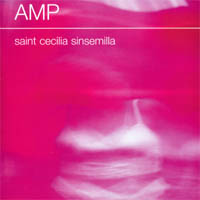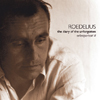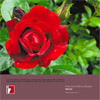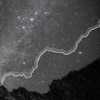- Administrator
- Albums and Singles
 The Amsterdam-based CD shop owner Elisabeth Esselink has deliveredanother bopping poppy soda-jerking sound-clashing long player as Solex.The new album is full of 15 peculiar yet captivating songs and is notyour regular haphazard clumsy mess. According to Matador's website,'Low Kick and Hard Bop' won out the title of this album, which also had'A Cross Between Cyndi Lauper and Early SPK' in the running. (You canguess which one would get my vote.) Esselink is asinger/multi-instrumentalist and clearly has a huge record collectionwhich probably dwarfs the one of Four Tet's Kieran Hebden. Bizarre,obscure samples combine with her playing and singing in a remarkablydemented world of tv game shows, Incredibly Strange Music collections,Hank Williams, Nancy Sinatra, Don Ho, and Herb Alpbert. Picture a crowdof awkward Dutch kids in blue jeans dancing messily around a 1950sburger shop. It's a world of big bright lights and loud colors, hairtossing and skirt twirling. Esselink proves she's not just anothersampladelic diva, but she is a pretty face too! I'm sure she takes herjovial art quite seriously and I can't wait to see her live again thisNovember where I ask her to be my wife. Check out www.solex.net for a really cool site and tour dates.
The Amsterdam-based CD shop owner Elisabeth Esselink has deliveredanother bopping poppy soda-jerking sound-clashing long player as Solex.The new album is full of 15 peculiar yet captivating songs and is notyour regular haphazard clumsy mess. According to Matador's website,'Low Kick and Hard Bop' won out the title of this album, which also had'A Cross Between Cyndi Lauper and Early SPK' in the running. (You canguess which one would get my vote.) Esselink is asinger/multi-instrumentalist and clearly has a huge record collectionwhich probably dwarfs the one of Four Tet's Kieran Hebden. Bizarre,obscure samples combine with her playing and singing in a remarkablydemented world of tv game shows, Incredibly Strange Music collections,Hank Williams, Nancy Sinatra, Don Ho, and Herb Alpbert. Picture a crowdof awkward Dutch kids in blue jeans dancing messily around a 1950sburger shop. It's a world of big bright lights and loud colors, hairtossing and skirt twirling. Esselink proves she's not just anothersampladelic diva, but she is a pretty face too! I'm sure she takes herjovial art quite seriously and I can't wait to see her live again thisNovember where I ask her to be my wife. Check out www.solex.net for a really cool site and tour dates.
samples:
Read More
- Administrator
- Albums and Singles
 After listening not nearly enough times, I find myself returning overand over to the same conclusion: amazing. Tara Jane's one of thosemusicians where those 'in the know' will already have everything shehas been a part of. Her multi-instrument playing and singing can beheard on Retsin, Rodan, and Sonora Pine records as well as her fabulousdebut solo release last year, 'Peregrine.' It's inevitable you'd misswho she is if you were also a fan of Rachel's, Ida, or Shipping News asshe's bound to be making an appearance at a show here or there or sharemusicians. There's something almost magical in nearly anything shetouches. I know it sounds queer but if you've ever paid witness to oneof her shows, the amount of bleedingly direct and honest charm whicheminates from her shines really bright. People at her shows can't helpbut be captivated and completely swept up. The recorded sound is a muchmore intricate woven tapestry, however, with a mishmosh of unpluggedinstruments and varying arrangements. 'Peregrine' was such a boldstatement, as Tara Jane collected some of her best friends in andaround NYC and created a solid album of intricate instrumentation, ascattering of styles and an honest production which makes the musicianssound like they're in your livingroom. There's a lot of similar facesstill around, like Dan Littleton of Ida, Rachel Grimes of the Rachel's,Cynthia Nelson of Retsin and Ruby Falls and Ida Pearle, but guestcontributions seem much less prominent than last time. Tara's comehome. This year's album sees her moving away from the urban setting,with more production in Louisville than NY, subsequently the music ismore vocal and the subject matter appears more personal. It almostseems to me as if she proved her point last time around — that she isan accomplished arranger and skilled instrumentalist. This time she'sgot more personal stories to tell as a developing songwriter, who'soften being compared to the likes of Joni Mitchell and Cat Power.Recently I bought a new pair of higher quality headphones and deeplistening has taken on a new meaning, this disc has not let me down.
After listening not nearly enough times, I find myself returning overand over to the same conclusion: amazing. Tara Jane's one of thosemusicians where those 'in the know' will already have everything shehas been a part of. Her multi-instrument playing and singing can beheard on Retsin, Rodan, and Sonora Pine records as well as her fabulousdebut solo release last year, 'Peregrine.' It's inevitable you'd misswho she is if you were also a fan of Rachel's, Ida, or Shipping News asshe's bound to be making an appearance at a show here or there or sharemusicians. There's something almost magical in nearly anything shetouches. I know it sounds queer but if you've ever paid witness to oneof her shows, the amount of bleedingly direct and honest charm whicheminates from her shines really bright. People at her shows can't helpbut be captivated and completely swept up. The recorded sound is a muchmore intricate woven tapestry, however, with a mishmosh of unpluggedinstruments and varying arrangements. 'Peregrine' was such a boldstatement, as Tara Jane collected some of her best friends in andaround NYC and created a solid album of intricate instrumentation, ascattering of styles and an honest production which makes the musicianssound like they're in your livingroom. There's a lot of similar facesstill around, like Dan Littleton of Ida, Rachel Grimes of the Rachel's,Cynthia Nelson of Retsin and Ruby Falls and Ida Pearle, but guestcontributions seem much less prominent than last time. Tara's comehome. This year's album sees her moving away from the urban setting,with more production in Louisville than NY, subsequently the music ismore vocal and the subject matter appears more personal. It almostseems to me as if she proved her point last time around — that she isan accomplished arranger and skilled instrumentalist. This time she'sgot more personal stories to tell as a developing songwriter, who'soften being compared to the likes of Joni Mitchell and Cat Power.Recently I bought a new pair of higher quality headphones and deeplistening has taken on a new meaning, this disc has not let me down.
samples:
Read More
- Administrator
- Albums and Singles
 It has been three years since the last Amp (proper) full-lengther, the phenomenal 'Stenorette' release on Kranky (produced by Robert Hampson of Main). Since then, there have been a couple releases as A.M.P. Studio (but don't ask me to describe the distinction between entities). While the world awaits another full-length masterpiece, the group has decided to collect recordings made on the road during their 1998/99 European tour, from in-studio performances at AJZ radio in Switzerland and the famed VPRO in the Netherlands.
It has been three years since the last Amp (proper) full-lengther, the phenomenal 'Stenorette' release on Kranky (produced by Robert Hampson of Main). Since then, there have been a couple releases as A.M.P. Studio (but don't ask me to describe the distinction between entities). While the world awaits another full-length masterpiece, the group has decided to collect recordings made on the road during their 1998/99 European tour, from in-studio performances at AJZ radio in Switzerland and the famed VPRO in the Netherlands.
Of the ten songs included, four I can recognize from both 'Stenorette' and 1997's 'Astralmoonbeamprojections'. In addition to the older tunes, the group has provided somewhat of a rough blueprint for the next recordings.
Amp's sound has always been rather difficult to categorize, whether they're making an attempt at dreampop, a blissful wall of sound, or gritty and abrasive guitar wash with samples. While the group are considerably limited to both gear and production due to the nature of these recordings, it's no easier to sum up the sounds. Common characteristics include earth-rumbling bass, disconnected looping drums and heavily distorted guitars underneath the caustic vocals of miss Karine Charff. From a low rumble to blood curdling shrieks, it's almost puzzling how dark and almost goth-like this can get while incorporating old sounds of primitive gear and effects — think early 1970s Pink Floyd noodle-roni — while their main crowd tends to be the more peculiar indie rock kids.
Have they played at Terrastock yet? Tom the Fish is calling this the best record of the year, while I'm now salivating for the next fully realized Amp (studio) album.
samples:
 
Read More
- Administrator
- Albums and Singles
 There's a lot of electronic music out there that either plain bores or annoys the absolute piss out of me. So much of it sounds the same, and what it sounds like is something so pedestrian that it was all created using standard ACID loop libraries. That's why it's so refreshing when something like loscil comes around. "Triple Point" is a fantastic release just based upon the rather unique palette of sounds here. But there's so much more going on in the mix. Sampled sounds so buried you really only hear them faintly, and treated keyboards that sound hollow and distant have such an eerie effect. Each track starts of easy enough, but builds to amazing heights as more sounds are added and volume increases. Scott Morgan, who is loscil, has an amazing ear, as these songs are dense and droned-out but you never lose sense of this music and Morgan never lets you stray from the path long. "Triple Point" is reportedly based on the concepts of thermodynamics, and that couldn't be a more appropriate analogy for the effect this music has on the listener. It soothes, it relaxes, it resonates with a warmth that almost defies description, and it propels you in the same instant, willing you to create or submit to its will. Never has an artist's debut on a label impressed me more. loscil has obviously just begun, and there's great promise for the future.
There's a lot of electronic music out there that either plain bores or annoys the absolute piss out of me. So much of it sounds the same, and what it sounds like is something so pedestrian that it was all created using standard ACID loop libraries. That's why it's so refreshing when something like loscil comes around. "Triple Point" is a fantastic release just based upon the rather unique palette of sounds here. But there's so much more going on in the mix. Sampled sounds so buried you really only hear them faintly, and treated keyboards that sound hollow and distant have such an eerie effect. Each track starts of easy enough, but builds to amazing heights as more sounds are added and volume increases. Scott Morgan, who is loscil, has an amazing ear, as these songs are dense and droned-out but you never lose sense of this music and Morgan never lets you stray from the path long. "Triple Point" is reportedly based on the concepts of thermodynamics, and that couldn't be a more appropriate analogy for the effect this music has on the listener. It soothes, it relaxes, it resonates with a warmth that almost defies description, and it propels you in the same instant, willing you to create or submit to its will. Never has an artist's debut on a label impressed me more. loscil has obviously just begun, and there's great promise for the future.
Samples can be found here.
Read More
- Administrator
- Albums and Singles
Mark Nelson (Pan American), Frank Bretschneider (Komet) and Joe Kingman (Fisherofgold) are given only one restriction for this project: approximately 15 minutes apiece to subjectively express themselves. I wonder why only 48 minutes total when most discs and players can accommodate 75-80? That question aside, volume 1 of this artist friendly series from Quatermass is a solid collection of complementary tracks.Pan American's "Train Station" and "The Passage" continue laying track beyond last year's delicious "East Coast Bugs" 12" on BSI. The latter in particular builds up a strong, pulsating head of dub steam with no time to pick up passengers 'til the end of the line. Komet specializes in economic titles, sounds and structures. His 3 tracks - "Stab", "Eist" and "Pass" - repetitively but progressively pop, click, boom and hiss, much like the digital 'pop' of his own "Rand" and "Curve" discs on Mille Plateaux. Fisherofgold uses nearly all of his allotted time for a single track. "Lapis Lazuli" (a semiprecious gemstone in varying shades of blue) evokes more of a golden than blue feel for me. Tiny ball bearings tumble around in a cement mixer as delicate rips and tears of audio are smeared about and a 7 note bass line loops. A languorous trip hop beat kicks in but is snuffed out within a few minutes. By the 9th minute it has slipped into a very comfortable and pretty groove adding a strummed accompaniment. And in the remaining time Kingman carefully strips away the elements 'til it comes to a sudden stop. I bought this disc for the Pan American and Komet but the Fisherofgold is best, though only marginally so as they're all quite pleasant. Now I wonder who will be on volume 2 ...
samples:
- Pan American - The Passage
- Komet - Pass
- Fishertogold - Lapis Lazuli
Read More
- Administrator
- Albums and Singles
 The sixth album in his Selbstportrait series, this is one of the best. Hans-Joachim Roedelius created this mini-masterpiece during the mid '70s, drawing on various recordings from his career at that time and building on them with added instrumentation and a wider selection of tones, structures and styles. The end result is a dazzling mix of old and new material (well it is all old at this stage considering the age of the album) which gives Roedelius’ talent the spotlight it deserves.
The sixth album in his Selbstportrait series, this is one of the best. Hans-Joachim Roedelius created this mini-masterpiece during the mid '70s, drawing on various recordings from his career at that time and building on them with added instrumentation and a wider selection of tones, structures and styles. The end result is a dazzling mix of old and new material (well it is all old at this stage considering the age of the album) which gives Roedelius’ talent the spotlight it deserves.
While not a break from the dreamy textures of his more famous works with Cluster and Harmonia (not surprising considering he recycles a lot of studio debris from various album sessions), the pieces that make up The Diary of the Unforgotten show a more intimate side to Roedelius’ musical personality. The rolling rhythms of "Frohgemut" conjure up images of a babbling brook where the water has been replaced with a rainbow; the playful side of Roedelius’ work that peeps through the starker aspects of his music in evidence here. In contrast, the almost classical piano of "Du," which immediately follows "Frohgemut," has more in common with Popol Vuh or even Debussy. The beautiful piano playing is stark naked in comparison to the synthesizers that populate the rest of The Diary of the Unforgotten.
A large proportion of The Diary of the Unforgotten is given over to "Hommage à Forst," a labyrinthine exploration of beats and rhythms that should be instantly recognizable to any student of Krautrock. Many of these backing tracks are taken directly from Cluster and Harmonia pieces and it is hard not to start humming or singing the absent but familiar melodies. Roedelius uses these backing tracks as a springboard for some studio jamming, even bringing in the most unusual instrument of all (for him): an electric guitar. A wobbly echo effect transmutates the loose guitar playing into a strange, organic counterpart to the mechanical rhythms.
The Diary of the Unforgotten is certainly one of Roedelius’ finer solo releases. It is Roedelius’ experiments with his approach to composing and playing around these familiar elements which make the album and the bits lifted from Cluster and Harmonia songs are the least exciting parts here. The idea of this being an audio self-portrait is most apt as Roedelius’ character shines through with a brilliance that is almost blinding.
samples:
 
Read More
- Creaig Dunton
- Albums and Singles
 Recorded live as a duet between turntables and keyboards (with editing and overdubbing bass added later), the main track here is a slow, dramatic piece, with the flip side conjuring the best moments of electronic dub.
Recorded live as a duet between turntables and keyboards (with editing and overdubbing bass added later), the main track here is a slow, dramatic piece, with the flip side conjuring the best moments of electronic dub.
While artists who specialize in the use of a turntable as an instrument are a dime a dozen, no one else really uses the device as creatively or as intensely as Jeck.Truly "playing" it, rather than just using it as a way to sample or scratch records, he coaxes sound out of the players that bear little or no resemblance to the source material."London Tenderberry" is a piece of slow drama that has no overt "record" sounds in it:shimmering synth pads, reverberated bangs and crashes, and a gurgling bass pulse meet to create a flowing river of opaque sound.The flip side, "Tenderberries Version" is not an ironic title at all, cutting the mix from the previous side up into throbbing bass and electronic synth pulses, leading to a complex variety of tone and rhythm, but with an intense dub sensibility that stands with the best of the genre.
Within the confines of a 7-inch record, I must admit that this is a case where less isn’t more.Sometimes a project or specific work is best kept within a sub-12 minute space, where it is able to make its statement without becoming stagnant or repetitive, but that's not this record.The complex nuances of the A side and the electro-like bass heavy flip just left me wanting more.Which is, I assume, the best compliment I could give.
Read More
- Creaig Dunton
- Albums and Singles
 Following up their four track debut (originally titled 4), here are two additional tracks from the former Clockcleaner vocalist's sideproject. Again, it is an exercise in unabashed goth revivalism, encapsulating the sensibilities of the genre without sounding like a tribute band or an overly derivative project. Here is simply two additional songs, following the mold set forth on the previous EP, of quality death rock with a modern influence.
Following up their four track debut (originally titled 4), here are two additional tracks from the former Clockcleaner vocalist's sideproject. Again, it is an exercise in unabashed goth revivalism, encapsulating the sensibilities of the genre without sounding like a tribute band or an overly derivative project. Here is simply two additional songs, following the mold set forth on the previous EP, of quality death rock with a modern influence.
With Clockcleaner, John Sharkey III always kept that early goth/new wave torch burning with his vocals and guitar work, but there it was often buried under a scum rock veneer, hiding the oft gentle sensibilities with Cro-Magnon street punk violence.With his solo work as Puerto Rico Flowers, there’s no obscuring this part of their sound."Voice of Love" goes the traditional path, with big, crashing drums and dour synthetic strings leading the darkened way, with overdriven fuzzed out bass laying the foundations.Flipside "When Your Lonely Heart Breaks" is a slow, lurching bass and drum zombie, meandering through with mantra-like repetitive vocals.While repetitive, it stays more hypnotic rather than getting boring, and the synth flourishes at the end only help the sound.On both tracks, Sharkey’s melodramatic, monotone vocals are reminiscent of almost any old school goth band, but no one in particular.
For all its unashamed sepulchral vocals and smeared black eyeliner, PRF probably is the most unassuming project for such classic death rock styling, both in name and imagery.I’m sure that’s how the famously sarcastic Sharkey wants it though. Pushing aside tired metaphors of books and their covers, this is a fresh alternative to simply replaying those old Bauhaus and Sisters of Mercy albums all the time.
Read More
- Administrator
- Albums and Singles
 While both of these artists have significant discographies in their various projects (Marcia Bassett is a member of Double Leopards and Hototogisu, while Jenny Gräf is half of Metalux), here in the context of a duo they've chosen to examine more varied and ambient sounds as opposed to the more noise and drone tinged works their other bands are known for.
While both of these artists have significant discographies in their various projects (Marcia Bassett is a member of Double Leopards and Hototogisu, while Jenny Gräf is half of Metalux), here in the context of a duo they've chosen to examine more varied and ambient sounds as opposed to the more noise and drone tinged works their other bands are known for.
The long opener "Zero as Sky" begins with a slow moving wave of buzzing drone which, to use a contemporaneous pop culture reference that will be meaningless in six months, sounds like the vuvuzelas that have been a locust in the media since their World Cup appearance this summer.The droning horn sounds are paired with overt guitar to create an odd duet, which takes an even more drastic turn when the layered, but otherwise untreated vocals appear.The piece transitions to deliberate guitar feedback and warbling birdsongs in a minimal, but tightly controlled mix.
The shorter middle segment, "Black Waters Glow" is perhaps the most inviting of the three pieces here.The pure, unprocessed guitar and bits of synth, when put alongside the lightly effected vocals give a very distinctive 1970s prog rock sound, at least in its approach.The track is far from the overblown pretense of that genre, and remains a rather sparse, low-key work throughout, with even the electronic elements kept to a minimum throughout to emphasize the guitar and vocal components.
The duo isn’t content to stay in these sparser, warm waters for long.The closing "Phantasmagorical Mapping" heads back into dark, mysterious realms.The treated static and low end swell that form the introduction pull away to leave the focus on bass drone and tremolo-ed guitar noise, which form the underlying skeleton of the piece.Percussion arrives, but in an erratically paced form that sounds more like a cassette tape being eaten by the machine.The low register elements swell to the point of raw clipping, but stay restrained and controlled.Even once the spacy electronics appear in the later moments, there is still a sense of lurking menace in the track that is only slightly lightened by the delicate vocals that close the track.
Peradam is not a light album by any means, but it does step away from the usual doom and gloom associated with this type of music.Instead, it embraces a world of texture and variation, using the similar paints of doom and drone, but in a different and varied way, developing a more dynamic style throughout.While it doesn't specifically resemble any of Bassett's other projects, her presence is definitely felt throughout.
samples:
 
Read More
- Administrator
- Albums and Singles
 As a follow-up to his last full-length solo album Northern, Deupree has once again captured the changes in seasons in an audio format. Rather than the vast expanse of ice and snow, Shoals is the sound of summer’s transition into fall, of weather-worn trees decaying and other vegetation making early preparation for the coming change.
As a follow-up to his last full-length solo album Northern, Deupree has once again captured the changes in seasons in an audio format. Rather than the vast expanse of ice and snow, Shoals is the sound of summer’s transition into fall, of weather-worn trees decaying and other vegetation making early preparation for the coming change.
Deupree utilized a variety of gamelan instruments from Java and Bali as the core of this project, not playing them traditionally but using their surfaces and construction as a means of creating sound.These sounds were recorded and then looped and digitally manipulated via computer, creating a hybrid of ancient organic and modern sounds.The results do not clearly bear the mark of either, instead representing a microcosmic world of music that balances abstraction and melody.
The title track hides melodic tones behind the soft creaking of wood, cut into rhythmic loops and then garnished with the occasional metallic clang, often reduced to a simple blip.Amongst the warm haze of decaying sound, there is the sound of natural movement:Deupree's movement amongst the instruments and microphone arrays during the recording sessions was captured by the recording devices.These "imperfections" in sound were treated as important as any of the other instruments, giving an even more human quality to a style that is often criticized as being too technologically focused.
The carefully restrained clatter of "Falls Touching Grasses" allows the stringed and percussive instruments to show through a bit of their natural color, but kept hushed and subtle, mixed among the pulses of fragmented sound.The combination of the almost collage-sounding dynamic bits and the distant reverberated notes creating a melodic counterpoint works quite well.The extremely textural "Rusted Oak" sounds as if it is hiding an acoustic guitar among its tactile layers, with the most subtle of percussion off in the distance.Of all the pieces, this one has the most natural sound, almost as if it were a field recording of an undiscovered land, complete with the sounds of a tree decaying to construct a relatively bleak sounding track among lighter ones.
While Deupree is a prolific artist, his full length solo albums are relatively infrequent.When they appear, they are as well developed and conceived as any modern composer.His work coaxes the most beautiful threads of sound out of natural and man-made sources and then weaves other-wordly textures with them, and uses them to create worlds that are inviting and compelling.Shoals is no exception to this, and perhaps is one of the best demonstrations of his strengths and creativity.
samples:
 
Read More
- Administrator
- Albums and Singles
 This isn't the first collaboration between these two that serves as excellent hot weather listening. While a lot of Andrew Chalk's recordings can seem dark and cold, this short release is serene in a very warm and comforting, almost blindingly bright way.
This isn't the first collaboration between these two that serves as excellent hot weather listening. While a lot of Andrew Chalk's recordings can seem dark and cold, this short release is serene in a very warm and comforting, almost blindingly bright way.
 
Originally released on vinyl in the summer of last year, and presented as an extended play single, these three pieces total less than 25 minutes, and while the collaborators have chosen to present the recordings in these versions, the fade-outs suggest there's more to them than what we're given.
There's a lot of movement in the stillness here. The faint rhythms on "Queen of Heaven" are only a backdrop to the very prominent sustained layers of keyboards and almost inaudibly low frequency bass. It's like watching the wind blow through tall blades of grass under a stale, mean, and old sun in the mid-afternoon. It's that time that is hottest and brightest before the sun begins to set. All the tall blades hold solid in their ground and sway elegantly, mimicking a water-like ripple with even the slightest breeze. While the instrumentation differs significantly from "Pale Shadow" (from 2007's Ghosts On Water) the hot and bright feeling achieved here is quite familiar.
The second piece, "Of Beauty Reminiscing" is more blatant on a few levels. It not only shares a title with a Vikki Jackman long player, it also incorporates some of Suzuki 's familiar cricket sounds, like those used on "Fuxen" from Chalk and Suzuki's first collaborative release, The Days After, released in 2003. These crickets, however, are faster and livelier, much like crickets heard at dusk. They make the ones from "Fuxen" sound like night time crickets about to fall asleep. Regardless, there's more melodic development here than on the early collaborations, and it continues through the closer, "The Water Clock," which, once again, has very prominent keyboard and bass, with a surprisingly loud, even pinching analog synth melody. It also features piano by Vikki Jackman and a stringed instrument (probably a guitar) being faintly plucked, almost Jandek-like, naked, and uncompressed. But these instruments only add a slight seasoning to the periphery.
I enjoy that the two have, for the most part, pared down their instrumentation, focusing more on what they have and what to do with it. They don't toss as many sources in as they have in previous sessions—there's no singing nor random piano banging this time around. Its brevity is a tease, unfortunately, as I could easily listen to much longer versions. In turn, I found myself repeating the album while doing late afternoon/early evening work in the recent hot weather.
samples:
Read More


